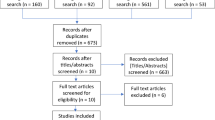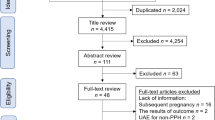Abstract
Uterine artery embolization (UAE) has been introduced for uterine fibroid treatment for two decades. Most of the patients are in reproductive age and many want future pregnancy. In this study, we will assess fertility, pregnancy and its outcomes in patients who have undergone UAE. In this systematic review, a systematic search was performed on important databases including PubMed and Medline, Web of Knowledge, Google Scholar, EMBASE and Scopus. Studies reported enough data about pregnancy after UAE were considered to be enrolled in the review. We assessed obstetric indices (pregnancy and delivery rates, pregnancy losses, complications and fetal outcomes). Study evaluation was done based on STROBE checklist by two reviewers. Totally, 24 original papers were included. Data were analyzed by Stata and MedCalc softwares. Among women wishing fertility, totally 40.5% experienced at least one pregnancy after UAE (95% confidence interval [CI]: 33.3%-48.2%). Pooled estimate of pregnancy loss rate was 33.5% (95% CI: 26.3–41%). Most pregnancy losses were due to spontaneous abortion (81.3% of all losses (95% CI = 76%-86.1%)). Rate of obstetrical complications was 25.4% (95% CI = 13–40.2%) among all finished pregnancies. Pooled estimate of preterm labor was 12.8% (95% CI = 8.7%-17.5%), and pooled estimate of low birth weight (LBW) was 10% (95% CI = 6.2–14.6%). Considering the findings of the study, a safe pregnancy after UAE is obviously possible resulting to a healthy and normal baby delivery. In addition, pooled obstetrical complication rates, pregnancy losses, preterm labor and LBW seem to be mostly similar to the general population. Registration: The study was registered in International Prospective Register of Systematic Reviews (PROSPERO) on Nov 3, 2017, and was confirmed with a registration code of CRD42017076074.






Similar content being viewed by others
References
Hassan M, Fouad H, Bahashwan S, et al. Towards non-surgical therapy for uterine fibroids: catechol-O-methyl transferase inhibitor shrinks uterine fibroid lesions in the Eker rat model. Hum Reprod. 2011;26(11):3008–18.
Cura M, Cura A, Bugnone A. Role of magnetic resonance imaging in patient selection for uterine artery embolization. Acta Radiol. 2006;47(10):1105–14.
Carranza-Mamane B, Havelock J, Hemmings R, et al. The management of uterine fibroids in women with otherwise unexplained infertility. J Obstet Gynaecol Can. 2015;37(3):277–85.
Marshall LM, Spiegelman D, Barbieri RL, et al. Variation in the incidence of uterine leiomyoma among premenopausal women by age and race. Obstet Gynecol. 1997;90(6):967–73.
Pokras R, Hufnagel VG. Hysterectomy in the United States, 1965–84. Am J Public Health. 1988;78(7):852–3.
Gupta JK, Sinha A, Lumsden MA, et al. Uterine artery embolization for symptomatic uterine fibroids. Cochrane Database Syst Rev. 2014;12:CD005073, https://doi.org/10.1002/14651858.CD005073.pub3.
Ravina JH, Merland JJ, Herbreteau D, et al. preoperative embolization of uterine fibroma. preliminary results (10 cases). Presse Med. 1994;23(33):1540.
Spies JB. Uterine artery embolization for fibroids: understanding the technical causes of failure. J Vasc Interv Radiol JVIR. 2003;14(1):11.
Spies JB, Roth AR, Gonsalves SM, et al. Ovarian function after uterine artery embolization for leiomyomata: assessment with use of serum follicle stimulating hormone assay. J Vasc Interv Radiol. 2001;12(4):437–42.
Worthington-Kirsch RL, Popky GL, Hutchins FL Jr. Uterine arterial embolization for the management of leiomyomas: quality-of-life assessment and clinical response. Radiology. 1998;208(3):625–9.
Gabriel-Cox K, Jacobson GF, Armstrong MA, et al. Predictors of hysterectomy after uterine artery embolization for leiomyoma. Am J Obstet Gynecol. 2007;196(6):e1–6.
Schirf BE, Vogelzang RL, Chrisman HB, editors. Complications of uterine fibroid embolization. In: Seminars in interventional radiology; Copyright© 2006 by Thieme Medical Publishers, Inc., 333.
Karlsen K, Hrobjartsson A, Korsholm M, et al. Fertility after uterine artery embolization of fibroids: a systematic review. Arch Gynecol Obstet. 2018;297(1):13–25.
Bonduki CE, Feldner PC Jr, Silva Jd, et al. Pregnancy after uterine arterial embolization. Clinics. 2011;66(5):807–10.
Carpenter TT, Walker WJ. Pregnancy following uterine artery embolization for symptomatic fibroids: a series of 26 completed pregnancies. Obstet Gynecol Surv. 2005;60(8):498–500.
Ciraru-Vigneron N, Ravina J, Aymard A, et al. Pregnancy after embolisation of uterine myomata. Minim Invasive Ther. 1999;8(6):407–10.
Dutton S, Hirst A, McPherson K, et al. A UK multicentre retrospective cohort study comparing hysterectomy and uterine artery embolisation for the treatment of symptomatic uterine fibroids (HOPEFUL study): main results on medium-term safety and efficacy. BJOG: Internat J Obstet Gynaecol. 2007;114(11):1340–51.
Firouznia K, Ghanaati H, Sanaati M, et al. Pregnancy after uterine artery embolization for symptomatic fibroids: a series of 15 pregnancies. Am J Roentgenol; AJR. 2009;192(6):1588–92.
Hamoda H, Pepas L, Tasker F, et al. Intermediate and long-term outcomes following uterine artery fibroid embolization. Eur J Obstet Gynecol Reprod Biol. 2015;191:33–8.
Holub Z. Clinical experience and fertility outcome after uterine artery occlusion and embolization. Gynecol Surg. 2008;5(1):7–14.
Kim HS, Paxton BE, Lee JM. Long-term efficacy and safety of uterine artery embolization in young patients with and without uteroovarian anastomoses. J Vasc Interv Radiol; JVIR. 2008;19(2):195–200.
Kim MD, Kim NK, Kim HJ, et al. Pregnancy following uterine artery embolization with polyvinyl alcohol particles for patients with uterine fibroid or adenomyosis. Cardiovasc Interv Radiol. 2005;28(5):611–5.
Mara M, Maskova J, Fucikova Z, et al. Midterm clinical and first reproductive results of a randomized controlled trial comparing uterine fibroid embolization and myomectomy. Cardiovasc Interv Radiol. 2008;31(1):73–85.
Mclucas B. Pregnancy following uterine artery embolization: an update. Minim Invas Ther. 2013;22(1):39–44.
McLucas B, Goodwin S, Adler L, et al. Pregnancy following uterine fibroid embolization. Internat J Gynecol Obstet. 2001;74(1):1–7.
McLucas B, Voorhees WD III. Results of UAE in women under 40 years of age. Minim Invas Ther. 2014;23(3):179–83.
Pabón IP, Magret JP, Unzurrunzaga EA, et al. Pregnancy after uterine fibroid embolization: follow-up of 100 patients embolized using tris-acryl gelatin microspheres. Fertil Steril. 2008;90(6):2356–60.
Pisco JM, Duarte M, Bilhim T, et al. Spontaneous pregnancy with a live birth after conventional and partial uterine fibroid embolization. Radiology. 2017;285(1):302–10.
Pron G, Mocarski E, Bennett J, et al. Pregnancy After Uterine Artery Embolization for Leiomyomata: The Ontario Multicenter Trial. Obstet Gynecol. 2005;105(1):67–766.
Ravina JH, Vigneron NC, Aymard A, et al. Pregnancy after embolization of uterine myoma: report of 12 cases. Fertil Steril. 2000;73(6):1241–3.
Redecha M, Mižičková M, Javorka V, et al. Pregnancy after uterine artery embolization for the treatment of myomas: a case series. Arch Gynecol Obstet. 2013;287(1):71–6.
Torre A, Fauconnier A, Kahn V, et al. Fertility after uterine artery embolization for symptomatic multiple fibroids with no other infertility factors. Eur Radiol. 2017;27(7):2850–9.
Torre A, Paillusson B, Fain V, et al. Uterine artery embolization for severe symptomatic fibroids: effects on fertility and symptoms. Hum Reprod. 2014;29(3):490–501.
Walker W, Pelage J. Uterine artery embolisation for symptomatic fibroids: clinical results in 400 women with imaging follow up. BJOG: Internat J Obstet Gynaecol. 2002;109(11):1262–72.
Walker WJ, Bratby MJ. Magnetic resonance imaging (MRI) analysis of fibroid location in women achieving pregnancy after uterine artery embolization. Cardiovasc Interv Radiol. 2007;30(5):876–81.
Walker WJ, McDowell SJ. Pregnancy after uterine artery embolization for leiomyomata: a series of 56 completed pregnancies. Am J Obstet Gynecol. 2006;195(5):1266–71.
Mara M, Kubinova K, Maskova J, et al. Uterine artery embolization versus laparoscopic uterine artery occlusion: the outcomes of a prospective, nonrandomized clinical trial. Cardiovasc Interv Radiol. 2012;35(5):1041–52.
Pisco JM, Duarte M, Bilhim T, et al. Pregnancy after uterine fibroid embolization. Fertil Steril. 2011;95(3):e5–8.
Czuczwar P, Stępniak A, Wrona W, et al. The influence of uterine artery embolisation on ovarian reserve, fertility, and pregnancy outcomes—a review of literature. Menaupause Rev. 2016;15(4):205–9.
Marci R, Mallozzi M, Di Benedetto L, et al. Radiations and female fertility. Reprod Biol Endocrinol. 2018;16:112.
Guo XC, Segars JH. The impact and management of fibroids for fertility: an evidence-based approach. Obstet Gynecol Clin. 2012;39(4):521–33.
CoG P. ACOG Committee Opinion Uterine artery embolization. Obstet Gynecol. 2004;103(2):403.
Chrisman HB, Saker MB, Ryu RK, et al. The impact of uterine fibroid embolization on resumption of menses and ovarian function. JVIR; J Vasc Interv Radiol. 2000;11(6):699–703.
Ryu RK, Chrisman HB, Omary RA, et al. The vascular impact of uterine artery embolization: prospective sonographic assessment of ovarian arterial circulation. JVIR; J Vasc Interv Radiol. 2001;12(9):1071–4.
Razavi MK, Wolanske KA, Hwang GL, et al. Angiographic classification of ovarian artery–to–uterine artery anastomoses: initial observations in uterine fibroid embolization. Radiology. 2002;224(3):707–12.
Ahmad A, Qadan L, Hassan N, et al. Uterine artery embolization for treatment of uterine fibroids: Effect on ovarian function in younger women. JVIR; J Vasc Interv Radiol. 2002;13(10):1017–20.
Payne JF, Robboy SJ, Haney A. Embolic microspheres within ovarian arterial vasculature after uterine artery embolization. Obstet Gynecol. 2002;100(5):883–6.
Ryu RK, Siddiqi A, Omary RA, et al. Sonography of delayed effects of uterine artery embolization on ovarian arterial perfusion and function. AJR; Am J Roentgenol. 2003;181(1):89–92.
Tropeano G, Di Stasi C, Litwicka K, et al. Uterine artery embolization for fibroids does not have adverse effects on ovarian reserve in regularly cycling women younger than 40 years. Fertil Steril. 2004;81(4):1055–61.
Kim HS, Tsai J, Lee JM, et al. Effects of utero-ovarian anastomoses on basal follicle-stimulating hormone level change after uterine artery embolization with tris-acryl gelatin microspheres. JVIR; J Vasc Interv Radiol. 2006;17(6):965–71.
Andersen A-MN, Wohlfahrt J, Christens P, et al. Maternal age and fetal loss population based register linkage study. BMJ. 2000;320(7251):1708–12.
Homer H, Saridogan E. Pregnancy outcomes after uterine artery embolisation for fibroids. Obstet Gynaecol. 2009;11(4):265–70.
Cresswell JA, Ronsmans C, Calvert C, et al. Prevalence of placenta praevia by world region: a systematic review and meta-analysis. Trop Med Internat Health. 2013;18(6):712–24.
Garmi G, Salim R. Epidemiology, etiology, diagnosis, and management of placenta accreta. Obstet Gynecol Internat. 2012;2012, 873929. https://doi.org/10.1155/2012/873929.
Qidwai GI, Caughey AB, Jacoby AF. Obstetric outcomes in women with sonographically identified uterine leiomyomata. Obstet Gynecol. 2006;107(2):376–82.
Stout MJ, Odibo AO, Graseck AS, et al. Leiomyomas at routine second-trimester ultrasound examination and adverse obstetric outcomes. Obstet Gynecol. 2010;116(5):1056–63.
Lee T, Silver H. Etiology and epidemiology of preterm premature rupture of the membranes. Clin Perinatol. 2001;28(4):721–34.
Steer P. The epidemiology of preterm labour. BJOG: Internat J Obstet Gynaecol. 2005;112:1–3.
Ananth CV, Ananth CV, Vintzileos AM. Epidemiology of preterm birth and its clinical subtypes. J Matern Fet Neonat Med. 2006;19(12):773–82.
Black RE Global prevalence of small for gestational age births. In: Embleton ND, Katz J, Ziegler EE, editors. Low-birthweight baby: born too soon or too small. Basel:Karger Publishers; 2015 p. 1–7.
Ebadi F, Ghashghaee A, Bragazzi NL, et al. Low birth weight in Iran: Implications from a systematic review of the literature and meta-analysis in the period 1999–2017. Med J Islam Rep Iran. 2018;32:13.
Funding
This research was supported by Tehran University of Medical Sciences (International Campus) by Grant Number 95-04-98-33756 and Ethic Number: IR.TUMS.VCR.REC.1395.1903. There are no financial conflicts within the past 5 years and for the foreseeable future, and authors have to express their grateful thanks from this organization.
Author information
Authors and Affiliations
Corresponding author
Ethics declarations
Conflict of interest
The authors declare that they have no conflict of interest.
Ethical Approval
For this type of study, formal consent is not required
Informed Consent
For this type of study, informed consent is not required
Consent for Publication
For this type of study, consent for publication is not required
Additional information
Publisher's Note
Springer Nature remains neutral with regard to jurisdictional claims in published maps and institutional affiliations.
Rights and permissions
About this article
Cite this article
Ghanaati, H., Sanaati, M., Shakiba, M. et al. Pregnancy and its Outcomes in Patients After Uterine Fibroid Embolization: A Systematic Review and Meta-Analysis. Cardiovasc Intervent Radiol 43, 1122–1133 (2020). https://doi.org/10.1007/s00270-020-02521-6
Received:
Accepted:
Published:
Issue Date:
DOI: https://doi.org/10.1007/s00270-020-02521-6




